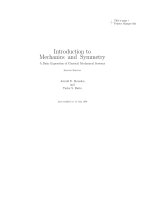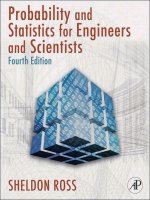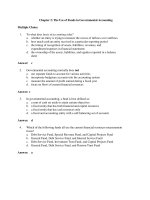Introduction to symmetry and group theory for chemists
Bạn đang xem bản rút gọn của tài liệu. Xem và tải ngay bản đầy đủ của tài liệu tại đây (745.01 KB, 133 trang )
INTRODUCTION TO SYMMETRY AND GROUP THEORY
FOR CHEMISTS
www.pdfgrip.com
This page intentionally left blank
www.pdfgrip.com
Introduction to Symmetry and
Group Theory for Chemists
by
Arthur M. Lesk
KLUWER ACADEMIC PUBLISHERS
NEW YORK, BOSTON, DORDRECHT, LONDON, MOSCOW
www.pdfgrip.com
eBook ISBN:
Print ISBN:
1-4020-2151-8
1-4020-2150-X
©2004 Springer Science + Business Media, Inc.
Print ©2004 Kluwer Academic Publishers
Dordrecht
All rights reserved
No part of this eBook may be reproduced or transmitted in any form or by any means, electronic,
mechanical, recording, or otherwise, without written consent from the Publisher
Created in the United States of America
Visit Springer's eBookstore at:
and the Springer Global Website Online at:
www.pdfgrip.com
Contents
Preface
ix
1. THE RELATIONSHIP BETWEEN GROUP THEORY AND
CHEMISTRY
1.1 Introduction
1.2 Applications of group theory
1
1
1
2. SYMMETRY
2.1 A bridge from geometry to arithmetic
2.2 Classifying symmetry operations
2.3 Full analysis of the symmetry of the water molecule: Introduction
to notation
2.4 Products of covering operations: multiplication tables
2.5 What is a group?
3
3
3
4
8
8
3. GROUP THEORY
3.1 Definition of a group
3.2 Subgroups
3.3 Examples of groups
11
11
12
13
4. POINT GROUPS – THE SYMMETRY GROUPS OF SMALL
MOLECULES
4.1 Introduction
4.2 Axes of rotation: Cn
4.3 Mirror planes: σ
4.4 Stereographic projection diagrams
4.5 Inversion: i
4.6 Rotatory reflections, or improper rotations, Sn
15
15
15
16
17
19
19
www.pdfgrip.com
vi
INTRODUCTION TO SYMMETRY AND GROUP THEORY FOR CHEMISTS
4.7
Catalogue raisonée of the common point groups: symbols,
molecular examples, and macroscopic examples
20
5. INTRODUCTION TO LINEAR ALGEBRA
5.1 Introduction
5.2 Systems of coordinates
5.3 Vectors
5.4 Norm or length of a vector
5.5 Angles and inner products
5.6 Generalizations to n dimensions
5.7 Orthogonality and normality
5.8 Linear transformations and matrices
5.9 Successive transformations; matrix multiplication
5.10 The effect on a matrix of a change in coordinate system
5.11 Orthogonal transformations
5.12 Traces and determinants
5.13 Matrix representation of symmetry groups
23
23
23
24
25
25
26
26
27
30
31
33
34
36
6. GROUP REPRESENTATIONS AND CHARACTER TABLES
6.1 Introduction
6.2 Group representations
6.3 Character tables
6.4 Properties of character tables
6.5 Calculations with character tables
39
39
41
46
48
49
7. MOLECULAR VIBRATIONS
7.1 Introduction
7.2 Classical description of molecular vibrations
7.3 Eigenvalue problems
7.4 Determination of the symmetries of the normal modes
7.5 Use of internal coordinates
53
53
54
57
60
63
8. ELECTRONIC STRUCTURE OF
ATOMS AND MOLECULES
8.1 The quantum-mechanical background
8.2 Symmetry properties of wave functions
8.3 Molecular wave functions
8.3.1 Properties of the exact wave functions
65
65
69
71
72
www.pdfgrip.com
vii
Contents
8.3.2
8.3.3
8.4
The Hartree-Fock approximation
The Linear Combination of Atomic Orbitals (LCAO)
approximation
Expectation values and the variation theorem
73
75
76
9. SYMMETRY PROPERTIES OF MOLECULAR ORBITALS
9.1 Diatomic molecules
9.2 Triatomic molecule – Walsh diagrams
9.3 Molecular orbitals for the bent AH2 molecule (C2v )
9.4 Molecular orbitals for the linear AH2 molecule (D∞h )
9.5 Correlation of orbitals between bent and linear geometries
83
83
87
87
89
90
10. SPECTROSCOPY AND SELECTION RULES
10.1 Introduction
10.2 The relationship between symmetry properties and the vanishing
of matrix elements
10.3 The direct-product representation
10.4 Selection rules in spectroscopy
10.4.1 Electronic transitions
10.4.2 Vibrational transitions
93
93
93
94
97
98
100
11. MOLECULAR ORBITAL THEORY OF
PLANAR CONJUGATED MOLECULES
11.1 Introduction
11.2 The LCAO–MO description of pyridine
11.3 Distribution of molecular orbitals among symmetry species
11.4 The Hückel approximation
11.5 Projection operators
11.6 General properties of projection operators
103
103
104
107
108
110
114
Conclusion
119
Index
121
www.pdfgrip.com
This page intentionally left blank
www.pdfgrip.com
Preface
This book is based on a one-semester course for advanced undergraduates
specializing in physical chemistry. I am aware that the mathematical training
of most science majors is more heavily weighted towards analysis – typically calculus and differential equations – than towards algebra. But it remains
my conviction that the basic ideas and applications of group theory are not
only vital, but not difficult to learn, even though a formal mathematical setting
with emphasis on rigor and completeness is not the place where most chemists
would feel most comfortable in learning them.
The presentation here is short, and limited to those aspects of symmetry and
group theory that are directly useful in interpreting molecular structure and
spectroscopy. Nevertheless I hope that the reader will begin to sense some of
the beauty of the subject. Symmetry is at the heart of our understanding of the
physical laws of nature. If a reader is happy with what appears in this book, I
must count this a success. But if the book motivates a reader to move deeper
into the subject, I shall be gratified.
Cambridge,
January 2004
www.pdfgrip.com
This page intentionally left blank
www.pdfgrip.com
Chapter 1
THE RELATIONSHIP BETWEEN GROUP
THEORY AND CHEMISTRY
1.1
Introduction
Group theory is a branch of mathematics that describes the properties of an
abstract model of phenomena that depend on symmetry. Despite its abstract
tone, group theory provides practical techniques for making quantitative and
verifiable predictions about the behavior of atoms, molecules and solids. Once
the basic ideas are clear, these techniques are easy to apply, requiring only
simple arithmetic calculations.
In this introductory treatment of the applications of group theory to chemistry, all mathematical tools are introduced and developed as they are needed.
Familiarity is assumed with only the basic ideas of Euclidean geometry, trigonometry and complex numbers.
1.2
Applications of group theory
Group theory has been useful in chemistry in several ways. First, it has
provided simple, qualitative explanations for the behavior of matter. For example, why can the states of electrons in any atom be classified, to a good
approximation, by the four quantum numbers n, l, ml and ms ? Why, in
their ground states, is BeH2 a linear molecule but H2 O bent? Why do certain transitions not appear in an absorption spectrum? Lengthy computations
can provide correct but uninformative answers to these questions; group theory can provide perspicuous explanations of the factors that determine these
answers.
At a more recondite level, group theory has helped in writing the grammars of the languages we use to describe the physical world. The principles
of quantum mechanics can be stated with conciseness, clarity, and confidwww.pdfgrip.com
2
INTRODUCTION TO SYMMETRY AND GROUP THEORY FOR CHEMISTS
ence because the properties of wave functions and linear operators are wellcharacterized by mathematics.
Together, qualitative understanding plus formal theory produce predictive
tools. The following questions survey the topics to be treated: How can we
describe, classify and predict
1 . . . the modes of vibration of a molecule?
2 . . . the possible shapes of the wave functions characterizing the electronic
structures of atoms and molecules?
3 . . . the spectroscopic properties of atoms and molecules; that is, their exchange of energy with radiation?
www.pdfgrip.com
Chapter 2
SYMMETRY
2.1
A bridge from geometry to arithmetic
A crucial reason for the importance of group theory in chemistry is that it
provides a quantitative description of the symmetry properties of atoms, molecules, and solids. It would be incorrect, however, to think that group theory
is only, or even mainly, a theory of geometric symmetry, because group theory
also describes the processes of ordinary arithmetic. Indeed the source of the
power of group theory in dealing with phenomena that depend on symmetry is
its establishment of a link between symmetries and numbers. It is the power
of this analogy, which provides arithmetic representations of geometrical operations, that makes it possible to derive geometric conclusions from simple
numerical calculations.
2.2
Classifying symmetry operations
A fundamental concept in the analysis of the symmetry of an object, such
as a cube or a water molecule, is the idea of a covering operation. A covering
operation is a geometrical transformation of an object that leaves it unchanged
in appearance. For example, the rotation of a water molecule by 180◦ around
an axis bisecting the H–O–H angle has the effect of exchanging the positions
of the two hydrogens, so that the molecule looks the same before and after the
rotation, as shown in Figure 2.1.
www.pdfgrip.com
4
INTRODUCTION TO SYMMETRY AND GROUP THEORY FOR CHEMISTS
Figure 2.1. Rotation by 180◦ is a symmetry operation of the water molecule.
A test for recognizing a covering operation is that it would go unnoticed by
an observer who was temporarily not looking while the operation was being
performed.
Many covering operations correspond to simple rotations – it is easy, and
most helpful, to try them out with molecular models. In addition, a “mirror reflection” of the distribution of matter in the water molecule in a plane passing
through the oxygen atom and perpendicular to the molecule is a covering operation. It is illustrated in Figure 2.2.
Figure 2.2. Reflection in a mirror plane is another symmetry operation of the water
molecule.
The complete list of covering operations of any object is a precise description of its symmetry.
2.3
Full analysis of the symmetry of the water molecule:
Introduction to notation
There is one covering operation that even the most asymmetric object must
have: the operation of leaving it alone. Like multiplying a number by 1, there
www.pdfgrip.com
5
Symmetry
is no effect, but this operation, called the identity, is as important in the study
of symmetry as the number 1 is to multiplication in arithmetic. The identity
operation will be denoted here by the letter E.
The rotation by 180◦ is denoted by the symbol C2 (C is curved, like the orbit
of an atom undergoing rotation, and the subscript 2 indicates that the angle of
rotation is 360◦ /2). A rotation by 120◦ = 360◦ /3 would be denoted by the
symbol C3 , What is the effect of the operation C1 ?
The mirror symmetry, the reflection in a plane perpendicular to the molecular plane, is denoted by the symbol σv . All mirror reflections are denoted by
the Greek letter σ: the subscript v indicates that the plane of symmetry would
be vertical if the molecule were drawn on a blackboard in the usual way.
A fourth covering operation of the water molecule is reflection IN the plane
of the molecule. This is also a vertical mirror; it is denoted by the symbol σv .
Table 2.1 summarizes the symmetry operations of the water molecule, and
records the final position of each atom after each operation.
Table 2.1. Symmetries of the water molecule.
Symmetry operation
Symbol
Final position of atom
originally located at:
H1
O
H2
Identity
E
H1
O
H2
Twofold rotation
C2
H2
O
H1
Reflection in mirror perpendicular
to molecular plane
σv
H2
O
H1
Reflection in molecular plane
σv
H1
O
H2
In the table, the symbols H1 , O, and H2 denote fixed locations in space, occupied initially (before the symmetry operation) by hydrogen and oxygen atoms.
It is customary to say, for example, that H1 is carried into H2 by the twofold
rotation C2 . This statement means that the hydrogen atom initially at the point
H1 is moved by the operation to the point H2 ; or, if H1 and H2 denote the
atoms themselves rather than the positions in space, that H1 is moved to the
position originally occupied by H2 . H1 is carried into H2 does not mean that
both hydrogen atoms are at the same point in space after the operation.
Table 2.1 shows that σv has the same effect on the water molecule as the
identity and that σv has the same effect as C2 . Are all four operations really
needed to describe the symmetry of the water molecule, or would E and C2 ,
for example, be enough?
www.pdfgrip.com
6
INTRODUCTION TO SYMMETRY AND GROUP THEORY FOR CHEMISTS
A comparison of the symmetry properties of the water molecule with those
of hydrogen peroxide shows that all four operations are necessary. Although
E and C2 are covering operations of H2 O2 , as shown in Figure 2.3, H2 O2 has
no plane of symmetry. Therefore it is essential to include all four covering
operations in a description of the symmetry of the water molecule, to indicate
that water has a higher symmetry than hydrogen peroxide.
180°
O
180°
O
O
Figure 2.3. C2 is a symmetry operation of both water and hydrogen peroxide, but
hydrogen peroxide has no plane of mirror symmetry. The orientation of the symmetry
axis in H2 O2 is perpendicular to the O–O bond and bisects the angle between the H–
O–O and O–O–H planes.
Is the set E, C2 , σv and σv a complete description of the symmetry of the
water molecule, or do additional covering operations exist? One way to try
to generate additional covering operations is by applying two known covering
operations in succession; for example, C2 followed by σv .
This compound operation must also be a covering operation of the water
molecule – it satisfies the criterion of undetectability by a temporarily distracted observer. However, it is not a new covering operation, but is equivalent to
σv .
The equivalence of two geometrical operations must be verified on an adequately asymmetric object. For example, E and σv have the same effect on
the water molecule, but they are certainly not the same geometrical manipulation. Figure 2.4a shows that a consideration of the water molecule alone cannot
determine whether the compound operation (C2 followed by σv ) is equal to σv
or to E; but that, for the case of a square rendered asymmetric by labeling the
corners (Figure 2.4b), the compound operation (C2 followed by σv ) is equivalent to σv and unequal to E.
www.pdfgrip.com
7
Symmetry
(a)
C2
O
H1
H2
O
(vertical axis)
H2
H1
σ'
σ
v
v
E
O
H2
H1
(b)
σv
A
B
C
D
C2
D
C
B
A
(axis into page)
σ'v
C
σv
D
C
D
A
B
σ'v
A
B
Figure 2.4. (a) For the water molecule the compound operation C2 followed by σv has
the same effect as the identity E or σv . (b) For a suitably-labeled square the compound
operation C2 followed by σv has the same effect as σv , but is not equivalent to the
identity E.
Thus the assertion that the compound operation (C2 followed by σv ) is equivalent to σv means not only that both produce the same result if applied to the
water molecule, but that both produce the same result if applied to any object
whatever, even an operation for which none of the transformations σv , C2 or
(C2 followed by σv ) is a covering operation.
Is it possible that consideration of other examples might expose a case in
which (C2 followed by σv ) does not give the same result as σv ? Rather than
proceeding inductively with additional tests, it will prove more effective to treat
the geometric manipulations as independent entities, without reference to illustrative objects on which they operate. The development of numerical representations of symmetry operations will then provide straightforward arithmetic
tests for equality.
www.pdfgrip.com
8
2.4
INTRODUCTION TO SYMMETRY AND GROUP THEORY FOR CHEMISTS
Products of covering operations: multiplication tables
It is usual to refer to the compound operation produced by applying two
operations in succession as the product of the two operations. In order to investigate further whether the products of the known covering operations of the
water molecule produce any new ones, it is helpful to construct a complete
multiplication table, shown in the box. Each entry in the table gives the operation resulting from applying first the operation at the head of the column
containing the entry, and then the operation at the left of the row.
E
C2
σv
σv
E
E
C2
σv
σv
C2
C2
E
σv
σv
σv
σv
σv
E
C2
σv
σv
σv
C2
E
No new covering operations have been generated – perhaps we have already
found all of them.
2.5
What is a group?
The fact that the product of any two of the four covering operations of the
water molecule is again one of the four can be expressed by the statement that
the set E, C2 , σv , and σv is closed under the rule of combination used. This is
one of the defining properties of a group. The set of all covering operations of
an object forms its symmetry group.
Other examples of sets that are closed under some rule of combination are
familiar. Consider the numbers 1 and −1, combining according to the rules of
ordinary multiplication:
1
−1
1
1
−1
−1
−1
1
or the complex numbers 1, −1, i and −i, again under multiplication:
1
−1
i
−i
1
1
−1
i
−i
−1
−1
1
−i
i
i
i
−i
−1
1
−i
−i
i
1
−1
As an important step towards appreciating the abstract concept of a group, try
to recognize what the set of covering operations of the water molecule and
these numerical examples have in common.
www.pdfgrip.com
9
Symmetry
In many extremely important cases, the analogy between a group of symmetry operations and a group of real numbers is more than superficial. For
example, consider the molecule α−chloronaphthalene:
✧❜❜✧✧❜
✧
❜
✧
❜
✧
❜
❜
✧
❜
✧
❜
✧
❜✧✧❜❜✧
1==Cl0-190
The covering operations of this molecule are only the identity E and a reflection in the plane of the molecule, denoted simply as σ. Compare the multiplication table of this group with that of the group formed by 1 and -1 under
multiplication:
E
σ
E
E
σ
σ
σ
E
1
−1
1
1
−1
−1
−1
1
The two multiplication tables have exactly the same structure. Whenever it
is possible to establish a one-to-one correspondence between the elements of
two groups, in such as way that the product of any two elements in one group
corresponds to the product of corresponding elements in the other group, the
two groups are said to be isomorphic. In this example the correspondence is
E ↔ 1 and σ ↔ −1. Because all properties of a group depend on its multiplication table, any property of a group is also a property of all isomorphic
groups.
In particular, a group of numbers isomorphic to a symmetry group is an
example of a representation of the symmetry group. Group representations
are of the utmost importance in chemistry because they make it possible to
achieve the effects of geometrical reasoning by means of calculations with the
numerical representations.
Problem 2–1. Is the symmetry group of the water molecule (Box, p.
8) isomorphic with the group formed by 1, i, −1 and −i under multiplication?
www.pdfgrip.com
10
INTRODUCTION TO SYMMETRY AND GROUP THEORY FOR CHEMISTS
Problem 2–2. Consider the symmetry group of an object for which the
only covering operations are the identity and rotations by 120◦ (= C3 )
and 240◦ (= C23 ) around the same axis. The multiplication table for this
group is:
E
C3
C32
E
E
C3
C32
C3
C3
C32
E
C32
C32
E
C3
Can you determine all the possible sets of three complex numbers that
satisfy the same multiplication table?
www.pdfgrip.com
Chapter 3
GROUP THEORY
3.1
Definition of a group
A group consists of a set (of symmetry operations, numbers, etc.) together
with a rule by which any two elements of the set may be combined – which
will be called, generically, multiplication – with the following four properties:
1 Closure: The result of combining any two elements – the product of any
two elements – is another element in the set.
2 Group multiplication satisfies the associative law: a · (b · c) = (a · b) · c for
all elements a, b and c of the group.
3 There exists a unit element, or identity, denoted E, such that E · a = a for
any element of the group.
4 For every element a of the group, the group contains another element called
the inverse, a−1 , such that a · a−1 = E. Note that as E·E = E, the inverse of
E is E itself.
Problem 3–1. Verify that the set of covering operations of the water molecule is a group, with the definition of the product of two operations as the compound operation resulting from applying them in
succession.
www.pdfgrip.com
12
INTRODUCTION TO SYMMETRY AND GROUP THEORY FOR CHEMISTS
Problem 3–2. For each of the following: Is it a group? If not, which
condition(s) fail? If the specified set does form a group under the specified operation, state what the identity element is, and give a formula
for the the inverse of any element.
(a) All integers – positive, negative and zero – under multiplication.
(b) The five integers −2, −1, 0, 1, 2 under addition.
(c) All odd integers under addition.
(d) All odd integers under multiplication.
(e) All even integers under addition.
(f) All even integers under multiplication.
(g) All real numbers under multiplication.
√
(h) All numbers of the form n1 + n2 5 where n1 and n2 are integers
(negative, zero or positive), under multiplication.
(i) The set of all rotations around a single axis; the rule of combination
is successive application.
3.2
Subgroups
A subgroup is a set of elements selected from a parent group that themselves
form group, with the additional condition that the product of two elements
in the subgroup must be the same as the product of the same two elements
considered as members of the larger group. For example, the group formed by
1 and −1 under multiplication is a subgroup of the group formed by 1, i, −1
and −i under multiplication:
1
−1
i
−i
1
1
−1
i
−i
−1
−1
1
−i
i
i
i
−i
−1
1
−i
−i
i
1
−1
In contrast, although the integers . . . , −2, −1, 0, 1, 2 . . . form a group
under addition, the group formed by 1 and −1 under multiplication is not a
subgroup even though both 1 and −1 are contained in the set of all integers.
Problem 3–3. Find all subgroups of the symmetry group of the water
molecule, in two ways: (a) For each symmetry element, try to find a
specific conformation of a related molecule, or of any geometric object,
that has all the symmetry elements except the one considered.
continues. . .
www.pdfgrip.com
13
Group theory
The symmetry group of that molecule or object is a subgroup of the
symmetry group of the water molecule.
(b) Make several copies of the multiplication table of the group. Cross
out all reasonable combinations of rows, and corresponding columns –
this has the effect of deleting certain elements – and determine whether
that which is left forms a group. Note that there is a total of 15 possibilities – see how many you can eliminate without actually trying them.
Make sure that you get the same answer both ways!
3.3
Examples of groups
1.
2.
3.
4.
5.
6.
7.
8.
9.
Elements of the group
covering operations of an object
All real numbers
All complex numbers
All real numbers except 0
All complex numbers except (0, 0)
All integers
Even integers
The n complex numbers of the form
cos 2πk
+ i sin 2πk
, k = 0, . . . , n − 1
n
n
All permutations of an
ordered set of objects
Rule of combination
Successive application
Addition
Addition
Multiplication
Multiplication
Addition
Addition
Multiplication
Successive application
A permutation is a specification of a way to reorder a set. For example, the group of
permutations of two objects contains two elements: the identity, first → first, second
→ second and the exchange, first → second, second → first. This group is isomorphic
to the group formed by 1 and −1 under multiplication.
a b
c d
10. All 2 × 2 arrays of complex
numbers of the form
·
aa + bc
ca + dc
a b
c d
a
c
b
d
ab + bd
cb + dd
such that ad − bc = 0
11. All 2 × 2 arrays of complex
a
numbers of the form
−b∗
such that aa∗ + bb∗ = 1
12. All possible rotations in
three-dimensional space
Same as example 10
b
a∗
Successive application
www.pdfgrip.com
=
14
INTRODUCTION TO SYMMETRY AND GROUP THEORY FOR CHEMISTS
Problem 3–4. The group of permutations of three objects contains six
elements (written in terms of cardinal rather than as ordinal numbers
to save space):
Initial position
1
2
3
→
→
→
1
2
3
Final position
2 3 1 3
3 1 3 2
1 2 2 1
2
1
3
Write the multiplication table for the group of permutations of three
objects.
Problem 3–5. Do you expect the group of permutations of three objects to be isomorphic to the symmetry group of the water molecule?
Explain your reasoning. Are the groups isomorphic?
Problem 3–6. Find the subgroups of the group of permutations of
three objects.
Problem 3–7. Verify that the 2 × 2 complex arrays of example 10 at
the beginning of this chapter form a group. Hints: (a) The difficulty in
verifying closure is the proof that if the condition ad−bc = 0 holds for
two 2 × 2 arrays, it holds for their product. Show by direct calculation
that (aa +bc )(cb +dd )−(ab +bd )(ca +dd ) = (ad−bc)(a d −b c ).
(b) Verify the associative law by direct calculation. (c) Verify that the
1 0
. (d) Verify that if ad − bc = D = 0, then
identity element is
0 1
a b
d/D −b/D
is
.
the inverse of
c d
−c/D a/D
Problem 3–8. For all twelve examples of groups in this section,
determine which groups are subgroups of others, and which groups
are isomorphic to others. Prepare a chart showing diagrammatically
the chains of subgroups, and connect the isomorphs by dotted lines.
(Warning! The relationship between examples 11 and 12 is quite
tricky.)
www.pdfgrip.com









